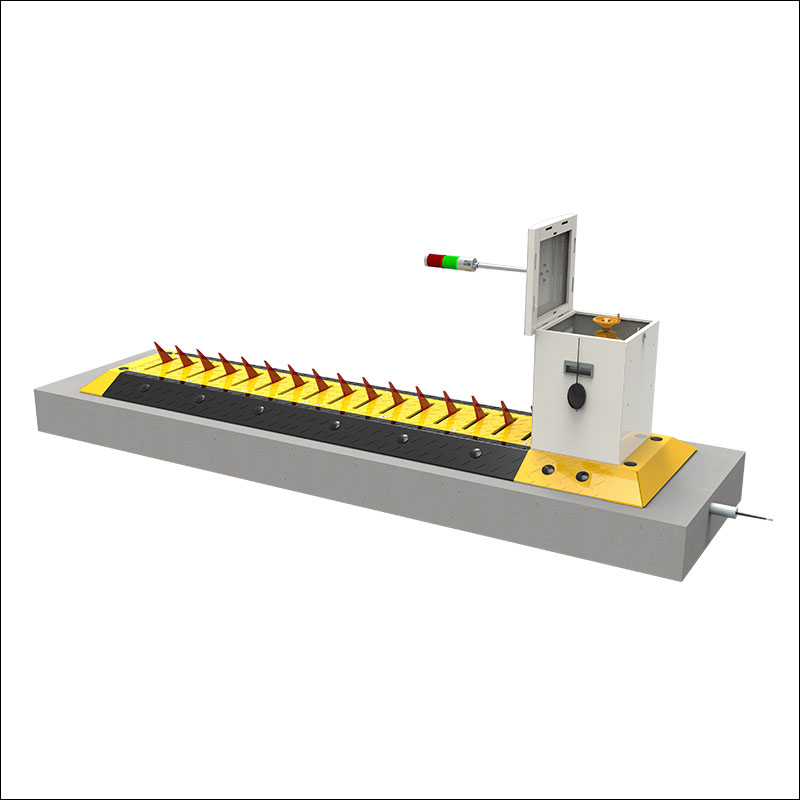Tyre killers are advanced security devices designed to prevent unauthorized vehicles from accessing restricted areas. These robust barriers are commonly used in high-security zones such as military bases, airports, government buildings, and industrial sites. By effectively puncturing and disabling vehicle tires, tyre killers provide a reliable means of controlling access and enhancing safety.
Understanding Tyre Killers
Tyre killers, also known as spike barriers or tire shredders, are mechanical devices installed on roadways or entrances to secure a perimeter. They consist of a series of sharp, steel spikes or blades that rise from the ground when activated. These spikes are designed to penetrate and destroy the tires of any vehicle attempting to pass over them, rendering the vehicle inoperable and preventing further movement.
Tyre killers are available in various designs, including surface-mounted and in-ground models. Surface-mounted tyre killers are installed directly on the road surface, while in-ground models are embedded into the ground for a more discreet appearance. Both types can be manually or automatically operated, depending on the level of security required.
How Tyre Killers Work
The operation of a tyre killer is straightforward yet highly effective:
1. Activation
Tyre killers can be activated manually by security personnel or automatically through integration with access control systems such as key cards, biometric scanners, or remote controls. When activated, the spikes or blades quickly rise from the ground, creating a barrier that prevents vehicles from passing.
2. Tire Puncture
If an unauthorized vehicle attempts to cross the barrier, the spikes penetrate the tires, causing them to deflate instantly. The sharp blades can also damage the rims and suspension, ensuring that the vehicle is immobilized. This immediate disabling of the vehicle prevents any potential threat from entering the secured area.
3. Deactivation
Once the threat has been neutralized, the tyre killer can be deactivated, allowing the spikes to retract into the ground. Authorized vehicles can then pass safely over the area without damage. In automated systems, the tyre killer can be programmed to reset automatically once the vehicle has been immobilized or the access control system grants permission for safe passage.

Heavy Duty TKB-30E Flush Mount Type Tyre Killer
Types of Tyre Killers
There are several types of tyre killers, each suited to different security needs:
1. Manual Tyre Killers
Manual tyre killers are operated by security personnel using a lever or control panel. These are ideal for locations where vehicle access needs to be tightly controlled, and immediate action is required. Manual systems are typically more cost-effective and are used in smaller facilities or areas with lower traffic volumes.
2. Automatic Tyre Killers
Automatic tyre killers are integrated with access control systems and can be operated remotely or programmed to respond to specific triggers, such as unauthorized access attempts. These systems are commonly used in high-security environments where swift and reliable response times are critical.
3. Surface-Mounted Tyre Killers
Surface-mounted tyre killers are installed directly on the road surface, making them highly visible and acting as a strong deterrent to unauthorized vehicles. These are easy to install and can be deployed in temporary or permanent locations.
4. In-Ground Tyre Killers
In-ground tyre killers are embedded into the ground, providing a more discreet and aesthetically pleasing solution. These are often used in locations where maintaining the visual appeal of the environment is important, such as corporate offices or luxury residential complexes.
Benefits of Using Tyre Killers
Tyre killers offer several advantages in securing premises:
1. Enhanced Security
Tyre killers provide a physical barrier that effectively prevents unauthorized vehicles from gaining access, ensuring the safety of sensitive areas. The instant disabling of vehicles reduces the risk of breaches and potential threats.
2. Deterrence
The presence of a tyre killer acts as a strong deterrent to unauthorized access attempts. The visible spikes or blades serve as a warning to drivers, discouraging any attempts to bypass security protocols.
3. Versatility
Tyre killers can be used in various settings, from high-security military bases to commercial properties. Their adaptability and ease of integration with existing security systems make them a versatile solution for a wide range of applications.
4. Durability
Constructed from high-strength steel, tyre killers are designed to withstand the impact of heavy vehicles and harsh weather conditions. Their durability ensures long-term reliability and minimal maintenance requirements.
FAQs About Tyre Killers
Q: Are tyre killers safe for authorized vehicles?
A: Yes, when deactivated, tyre killers pose no threat to authorized vehicles. The spikes retract completely, allowing vehicles to pass safely over the area without damage.
Q: Can tyre killers be used in high-traffic areas?
A: Yes, tyre killers can be designed for use in high-traffic areas. Automated systems with quick activation and deactivation cycles are particularly suited for busy environments, ensuring security without causing delays.
Q: What happens if a vehicle accidentally crosses a tyre killer?
A: If a vehicle crosses an activated tyre killer accidentally, the tires will be punctured, and the vehicle will be immobilized. It’s important to clearly mark and signpost areas where tyre killers are installed to prevent accidental crossings.
Conclusion
Tyre killers are an essential component of modern security systems, providing robust protection against unauthorized vehicle access. Their ability to instantly disable vehicles and their adaptability to various security needs make them a valuable investment for any high-security facility. By understanding how tyre killers work and when to use them, you can enhance the safety and security of your property.


